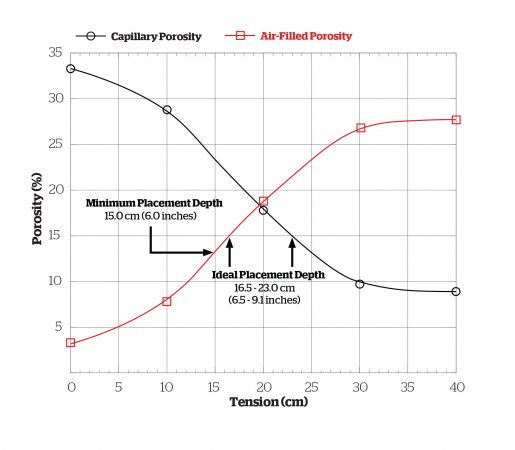
Features
Golf
Sand capping: one of golf’s finer arts
More consistent surface, better drainage among its attributes
June 15, 2021 By Jim Thomas
 Finding the right sand can be expensive, but a soil laboratory can be helpful in finding one that is suitable. Photo courtesy Thomas Turf Services.
Finding the right sand can be expensive, but a soil laboratory can be helpful in finding one that is suitable. Photo courtesy Thomas Turf Services. A popular way of improving the playability and performance of turf on golf courses is by sand capping the tees, fairways and even the roughs. The effectiveness of sand capping has been proven. However, achieving a result is only possible when all parameters have been well established and are monitored regularly.
Sand capping – the art of adding several inches of sand or a high-sand mix to improve the turf growing conditions by increasing the drainage of the surface – has really gained momentum since the start of this century. It has proven to deliver a more consistent surface with a rapid drainage capability that remains firm, even in wet conditions.
Once finished, the turf is more resistant to compaction. Sand capping can also eliminate certain problems associated with turf growth in poor soils, as well as create a more conducive growing medium.
The practice does not always get the recognition it deserves – the reason being that in most instances, the effect of sand capping is limited, due to incorrect decisions. In an attempt to reduce construction cost, architects or owners of golf courses do not always respect the ideal depths of the sand layer that is added.
While adding too thin a layer of sand saves costs, it may result in wet conditions and poor soil aeration, which may limit turf growth and health. Another reason is because the drainage capacity of the surface and health of the turf is, ultimately, determined by a complex mixture of conditions and circumstances.
The right match with water
The effect of sand capping can often be most striking when reclaimed water is used to water the turf. Reclaimed water generally contains elevated levels of bicarbonates, carbonates, salts, sodium and other materials that can adversely affect turf health, either directly or indirectly.
For that reason, good knowledge and understanding of the local conditions is required before it can be decided which quality and what quantity of sand should be added.
Using the incorrect sand can affect both the drainage capacity and water retention ability of the soil. Important characteristics for the sand to have are the correct particle size, water retention characteristics and angularity.
A soil laboratory can help in identifying suitable sands that perhaps can be expensive, but will deliver better performance while using a lower quantity. The soil laboratory can help understanding of the sand characteristics and local conditions which are essential to make a difference.
Ideal capping depth layer
Sand capping can only be as effective if the root system of the grass can root deeply and extensively. Only when this has been tested and established by a soil testing laboratory is it possible to determine how much sand should be added. A perfect depth will deliver the optimal balance of water-to-air-filled porosity.
This will generate the optimum growing conditions for the turf. At present, the United States Golf Association (USGA) doesn’t have specifications for sand-based construction directly atop existing soil. However, studies have shown that the root mass detected within the underlying subsoil can be inversely proportional to sand-cap depth.
If too much sand is applied to the turf, the grass roots will concentrate in the new sand layer. Sand used for sand capping doesn’t always have the nutrients a good root system prefers. Particularly in periods of drought or limited access to water, this sand could negatively affect the grass’ natural abilities of surviving and recovering from these conditions.

Example of a water release curve showing air filled and capillary (water filled) pore space as a function of sand depth (tension) from which one may predict the ideal and minimum placement depths.
Continual monitoring
Once the sand has been added, it is likely that maintenance practices will have to be adjusted. Effort must be made to avoid the accumulation of organic matter. An effective maintenance regime includes a combination of aeration, topdressing, verticutting and grooming.
These maintenance activities will help prevent the thatch layer from retaining excess water, which can result in a very poor growing environment. The thatch layer can also obstruct the water from moving more deeply into the soil profile, which can result in excessively dry soil beneath the layer.
When the majority of the root system is confined to the thatch layer, this will result in a grass plant that is far more susceptible to disease, insects and other stresses. Meanwhile, starving the soil of moisture and nutrients could result in lasting damage to turf.
The practice of sand capping is one that, to be successful, needs to be done carefully, and the response of the grass needs to be closely observed. Only when the existing conditions have been determined by a soil laboratory, and the knowledge obtained is used to produce a roadmap for the condition of the turf that is aspired to in the future, will it be useful to sand cap in that area.
Jim Thomas is owner of Thomas Turf Services, in College Station, Texas, a soil analysis and turf management company with clients worldwide. It was the second laboratory to be accredited by the American Association for Laboratory Accreditation, for the geotechnical evaluation of putting green materials. In 2019, the company joined the Labosport group of companies – a leader in the testing of both natural and synthetic turf surfaces. Being part of Labosport International entitles Thomas Turf Services to draw from and contribute to experiences and expertise for the building and maintenance of quality turf facilities.
Print this page